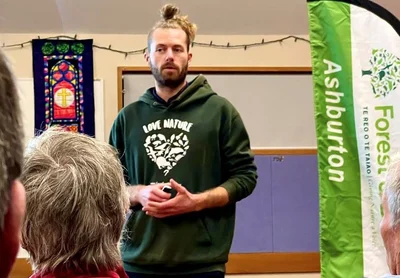Difficult conversations needed

Rivers need more space than people are willing to give them, a Forest & Bird freshwater advocate says.
Tom Kay pulled no punches at a presentation at St Stephen's Church in Ashburton this week.
Extreme weather events were going to become more frequent and more severe across New Zealand, putting communities next to rivers at increased risk.
He urged the Ashburton District to start the difficult conversation on how to manage local rivers.
"It's got to be a community conversation."
Mid Canterbury has had two major floods in recent years which caused millions of dollars of damage.
The Rangitata River flooded in December 2019 during a six-day downpour, flooding homes, wiping out communication and effectively cutting the South Island in two.
At the end of May and into June 2021 torrential rain hit the wider Canterbury area. In Mid Canterbury, State Highway 1 closed after the Ashburton Bridge was damaged and flood water inundated farms.
Kay said climate change had made New Zealand a "loaded dice" for tropical storms. As extreme events become more common a one-in-100-year flood would become a one-in-50, or even one-in-20-year event.
When a one-in-100-year flood became a one-in-20-year event, the likelihood that stopbanks would overtop or breach was 92%.
Kay said New Zealand's approach to managing rivers was to constrain them when in reality, rivers naturally change course suddenly.
Rivers created a natural terrace. But rather than build stopbanks at the edge of the terrace the approach had been to squeeze the rivers in.
"The attitude was we can control the rivers, turn them into big drains, and take the water straight out to sea as fast as possible."
As a result, rivers were straightened, concreted in parts, and controlled by stopbanks, Kay said.
"There are unintended consequences to managing rivers this way."
This included the loss of rapids, riffs, and pools - and a loss of habitat for fish and other creatures, as well as popular swim holes enjoyed by humans, Kay said.
Kay said New Zealand had brought flooding issues upon itself by narrowing rivers with stopbanks and building on flood plains behind them.
Changing the flow of rivers also affected the way rivers distribute sediment. As the sediment built up, you ended up with rivers perched above the flood plain.
"You can't build stopbanks higher," Kay said.
With higher stopbanks, a larger volume of water, moving with more energy, would build up and create a larger flood when the banks were breached.
The stopbanks also created a virtual dam behind them, making the flooding worse, Kay said.
Kay said communities need to "rethink our relationship with rivers".
Some places might need managed retreat. In other areas, giving the river more space could be enough, such as building stopbanks on the edge of river terraces.
The historical flow of rivers and input from people who live alongside the rivers was needed to develop a solution that would work for each community.
Responding to a question from the audience concerned about losing fertile farmland on the floodplain, Kay said the was a need to give some of the floodplains back to the river.
It was possible to use the land - but "you need to accept that it will flood".
Kay has been on a speaking tour across New Zealand as part of a Forest & Bird campaign to encourage the Government to invest in “nature and climate-friendly” solutions.
Environment Canterbury's (ECan's) acting general manager of operations Leigh Griffiths said climate change had increased the cost and complexity of maintaining and improving flood protection.
"Ashburton was one of the hardest hit areas in the 2021 flooding."
The amount of rain that fell in the upper catchment was much larger than the flood protection measures were ever designed to withstand, Griffiths said.
She acknowledged that the stopbanks along parts of the Ashburton/Hakatere River were "quite close together".
"We have started a community conversation about moving some of these but it's complicated and very expensive when private land is involved."
Griffiths agreed that climate change would increase the likelihood, and severity, of rain events.
Historically, people settled along rivers to use the resources they provided, she said.
"While this has enabled intensive use of fertile land, economic development, and access to food, water and recreation, it also comes with risks which have traditionally been addressed by flood protection.
"As we experience more frequent and severe weather events causing damage to our flood protection infrastructure, the community’s ability to continue funding this work is challenging."
Griffiths said co-investment from the Government enabled ECan to deliver work faster and more efficiently than from funding from rates alone - and co-investment was crucial to future flood protection.
Canterbury had received more than $40-million from shovel ready and flood recovery funding to fast track river projects over the last three years.
Giving rivers more room to move was one of many tools in the box for river management, she said.
"There’s no one-size-fits-all when it comes to flood protection and Canterbury’s braided rivers with their wide riverbeds and massive variation in flow, add extra complexity to these issues.
"Alongside mana whenua and the community, we must consider things such as the river's proximity to urban environments, existing and historical biodiversity and mahinga kai values, climate change impacts, the funding availability and more."
By Sharon Davis

